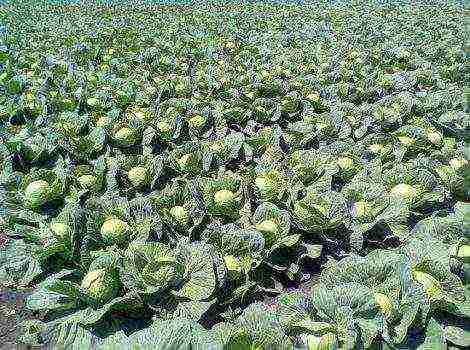Content
- 1 Spicy, semi-sharp, sweet onions - looking for differences
- 2 Popular varieties of red, yellow and white onions
- 3 Varietal variety of onions: what types are there?
- 4 The most popular onion varieties
- 5 The best bulbs for the Moscow region
- 6 What are the varieties of onions
- 6.1 Onion variety Bessonovsky photo
- 6.2 Onion variety Buran photo
- 6.3 Onion variety Arzamas photo
- 6.4 Moldavian onion variety photo
- 6.5 Onion variety Boterus photo
- 6.6 Onion variety Red Baron photo
- 6.7 Siberian annual onion variety
- 6.8 Onion variety Black Prince photo
- 6.9 Strigunovsky onion variety photo
- 6.10 Timiryazevsky onion variety photo
- 6.11 Onion variety Exibishen photo
- 7 Onion varieties for central Russia
- 7.1 Onion variety Shetana MC photo
- 7.2 Onion variety Stuttgarner Riesen photo
- 7.3 Onion variety Spirit F1 photo
- 7.4 Onion variety photo
- 7.5 Onion variety Mayachkovsky 300 photos
- 7.6 Onion variety Mstersky photo
- 7.7 Onion variety Odintsovets photo
- 7.8 Onion variety Danilovsky 301 photos
- 7.9 Onion variety Commissar photo
- 7.10 Onion variety Hercules F1
- 7.11 Onion variety Alvin photo
- 7.12 Onion variety Albion F1 photo
- 7.13 Onion variety Globo photo
- 7.14 Onion variety Schnitt photo
- 8 Growing technology and care of onions in the open field (with video)
- 9 The best varieties of onions and their photos
- 10 Growing, care and reproduction of shallots (with photo)
- 11 Shallot varieties and their photos
- 12 Growing and caring for chives in the open field (with photo)
- 13 The best varieties of chives
- 14 Growing conditions and care for leeks (with video)
- 15 The best leeks for the middle lane
- 16 The best varieties of onion-batuna, planting, care and cultivation
- 17 Multi-tiered onions: planting, care and cultivation (with photo)
Do you want to grow onions but don't know which variety to choose? Then be sure to read our article.
We will introduce you to the best varieties of onions that you can grow on your site without any problems.
When choosing a variety of onions for a summer residence, pay attention to its regionality. Depending on the area of growth, onion varieties can be divided into 2 types:
- southern;
- northern.
Southern varieties of onions do not last very long, but they are not very spicy in taste. Some of them are called sweet at all and are referred to as salad types of onions. If you want to get southern varieties of onions in the northern regions or in the middle lane, it is worth growing them through seedlings.
Northern varieties of onions are pungent in taste, but have excellent keeping quality.
White onions are also distinguished. It has a softer and sweeter taste. White onions are among the salad varieties. However, such bulbs are poorly stored, quickly damaged by pests, soften and rot.
In France, it is from white onions that the famous onion soup is prepared.
Onion varieties are also distinguished according to the growing season: in the early varieties this period is 90-100 days, in the middle ones - 100-120 days, and in the later ones - more than 120 days.
Depending on the size of the bulb, there are 3 types:
- small - less than 50 g;
- medium - 50-100 g;
- large - more than 100 g.
Depending on how many bulbs can form in the nest, varieties are distinguished:
- small-sized (1-2 bulbs);
- medium-sized (3-4 bulbs);
- multi-nested (5 or more bulbs).
Nesting largely depends on the size of the seedlings, as well as on the growing conditions of the crop. If the seed is larger, and the soil fertility and moisture is higher, then the number of bulbs in the nest will be greater.
Spicy, semi-sharp, sweet onions - looking for differences
All spicy varieties of onions are early ripening.They are distinguished by good keeping quality, high content of essential oils and sugars, but at the same time they are less productive. Such varieties, as a rule, are covered with several layers of outer scales, and therefore they can be removed not only manually, but also using specialized equipment.
Peninsular onion varieties have few outer scales, and the flesh is not as dense and sharp. Such a bow, when harvesting with special equipment, is often injured and quickly deteriorates. Semi-sharp varieties are considered to be medium-hard and take longer to ripen. However, they give a higher yield than sharp varieties.
Sweet onions taste great and are often used fresh. They give a high yield, but it is stored for a short time. Sharp and semi-sharp onions can be grown in any region. In the southern regions, during the growing season, crops can be obtained even from seeds. And in the middle lane and northern zones - only through seedlings or by planting seedlings. Sweet varieties are grown mostly in hot southern regions from seeds.
Popular varieties of red, yellow and white onions
We bring to your attention well-proven varieties of onions, which are preferred by the absolute majority of gardeners.
Kaba
Late-ripening variety with dense round-flat and rounded bulbs running downwards. The pulp is white, sometimes with a greenish tinge. The outer scales are yellow or light brown. The variety is not resistant to downy mildew (downy mildew), it is also damaged by onion fly.
| Use | Taste | Growing method | Bulb weight (g) | Keeping quality | |
| peninsular |
70-145 |
unsatisfactory | |||
Red baron
Early ripe variety. The bulbs are round, flattened at the top and bottom, red or dark purple on the outside and inside. For larger bulbs, it is recommended to grow this variety through seedlings.
| Use | Taste | Growing method | Bulb weight (g) | Keeping quality | |
| peninsular |
130-150 |
excellent | |||
Snowball
A medium early variety of white onions. It has almost round and white (both outside and inside) bulbs. Quite resistant to shooting, but moderately susceptible to downy mildew and neck rot.
| Use | Taste | Growing method | Bulb weight (g) | Keeping quality | |
| peninsular |
120-200 |
average | |||
Strigunovsky local
An early early ripening variety. It has round, dense bulbs with light pulp and pink or brown outer scales. It can grow in both hot and cool climates without problems.
| Use | Taste | Growing method | Bulb weight (g) | Keeping quality | |
| very spicy |
45-80 |
excellent | |||
Sturon
Mid-season variety. The bulbs are round, white in color, densely covered with a yellow-brown skin. Resistant to diseases and shooting.
| Use | Taste | Growing method | Bulb weight (g) | Keeping quality | |
|
|
spicy |
70-180 |
excellent | ||
Texas yellow
Early ripe variety. The bulbs are round, rather large, straw-yellow in color with dense white flesh. Resistant to pink root rot.
| Use | Taste | Growing method | Bulb weight (g) | Keeping quality | |
| peninsular |
|
80-150 |
average | ||
Centurion F1
Medium early hybrid with medium-sized, round-elongated bulbs. The pulp is juicy, white, the outer scales are golden brown. The hybrid is resistant to shooting and major onion diseases.
| Use | Taste | Growing method | Bulb weight (g) | Keeping quality | |
| spicy |
65-150 |
excellent | |||
Each of these varieties has stood the test of time and is popular with gardeners. Pay attention to them when you go to the store for sets or onion seeds.
Onions are used for cooking many dishes, so any housewife, when choosing crops for growing on her site, prefers several varieties at once. Variety in the beds allows you to create new masterpieces in the kitchen, and at the same time improve in gardening. In this article, we will find out what types of onions are, home and wild, talk about their description and find out the main characteristics.
Varietal variety of onions: what types are there?
Adopting the experience of their ancestors, preference is often given to the same varieties of onions when planting a vegetable garden. It's time to change stereotypes, improve and achieve new results, because the dish can sparkle with new flavor notes if you use Setton or Leek instead of the usual onion. Moreover, in central Russia, you can plant a large number of varieties, as practice has shown. At least lettuce, even green. And then we will find out where which species can grow.
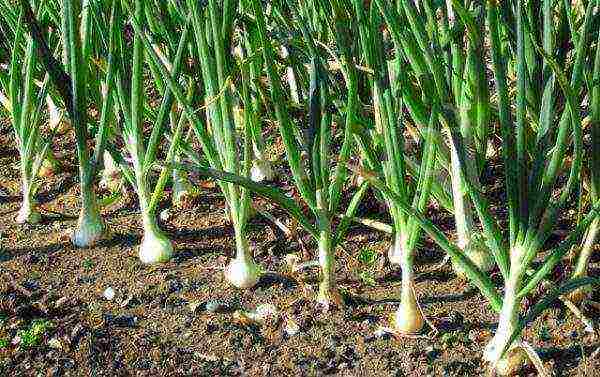 Onions in the garden
Onions in the garden
To determine the choice of seeds for bulbous plants, you need to familiarize yourself with the features of different species, their preferences and planting nuances. It is also worth paying attention to the correspondence of the growing conditions of the culture and the climate of the region. This is what will be discussed in this article.
The most popular onion varieties
All varieties of culture differ not only in taste, but also in planting rules, ripening period, and yield.
Onion sets
- Chalcedony grows outdoors, is very popular among gardeners in the southern regions of Russia. Suitable for growing feathers and root crops. The ripening period (from planting to harvesting) is 95-110 days. An average of 4 kg is removed from a square meter with a marketable weight of one small specimen of 85-100 grams. Sometimes there are onions weighing up to 400 grams. There is a good immunity to peronosporosis, vulnerability to cervical rot. Taste: pleasant with a slight spice.
- Stuttgarter Riesen early ripening, from sowing to harvesting takes about 3 months. Rounded-flat onions weigh 150-250 grams on average, but there are also giants up to 350 grams. The plant rarely shoots arrows, does not become covered with spots typical of downy mildew. Taste: spicy with a pungent aroma.
- Sowball is characterized by large, rounded bulbs with an average weight of up to 200 grams. The root crop ripens for about 100-110 days, gives a good harvest. Taste: delicate with a slight hint of pungency, used mainly for making salads.
Onions (turnip)
- Goldfish represents a mid-season species, differs in round, medium-sized onions weighing about 60-70 grams. Used for greenery and growing turnip for planting next season. The middle is white and juicy with a slight edge.
- The shaman belongs to the early ripening varieties, ripens in 86-95 days. The root crop has an elongated shape, a pink-red rather juicy middle. The average weight of a turnip is 55-65 gr. Advantages: stable high yield, high taste. Stored for a short time.
- Oporto ripens in 98-107 days, belongs to the mid-season species. The weight of the turnip reaches 270-300 gr., The shape is correct round. Advantages: high yield when using seedlings, immunity to diseases and pests, retains its presentation for a long time. The palatability allows the use of porto for all types of processing.
Varieties of salad onions
- Exibishen ripens for about 130 days and tastes very sweet with abundant juice. The turnips are round and very large, reaching 550 gr., But there are also specimens of 700-800 gr. The only drawback of the culture is considered a small storage period (no more than 3 months).
- Yalta is incredibly popular due to its excellent taste. The plant ripens in 138-150 days, turnips are large flattened purple tones, reaching an average of 200 grams. In the middle lane, the variety can be grown using seedlings. Onions are stored for up to 4 months.
- Ermak is the ripening record holder, the crop is removed 75-95 days after sowing. Differs in good immunity, long shelf life (up to the next season). The gastronomic feature is a soft juicy texture with a slight pungency.
Red onion
- The crimson ball ripens in 85-95 days, yields a stable harvest every year. Dark purple rounded turnips live up to the name. The middle is juicy with a pleasant taste, set off by a light speck.The drawback is the short shelf life (up to 4 months).
- Campillo F1 Introduces Red Onion Hybrid, which has a rounded shape with a dense center and a pleasant purple tint. Advantage - pigment does not transfer to kitchen utensils and fabrics. Taste qualities: delicate structure with abundant juice production, well-perceptible sweetness. It can be stored for a long time without losing its properties.
- Retro is famous for its high yield and fast ripening (up to 90 days). The middle is tender, dark red with white stripes. Onions are very sweet without pungency, so they are even added to children's salads.
White onion
- Albenka is fast ripening (up to 95 days) and interesting taste qualities that combine light pungency and sweetness. Grown for herbs and onion sets. Not suitable for long-term storage.
- The white globe has good seed germination and quick ripening. You can harvest the crop in 95-105 days after planting. A rounded, slightly elongated turnip weighs an average of 160 grams. The variety has a high stable yield, immunity to fusarium.
- Sterling is a group of white onion hybrids with a ripening period of 110-120 days. The mass of an average turnip is 120-200 gr. Rounded shape with white husk. The middle is soft and juicy with an unusual taste that is not similar to other species. The storage of the root crop is short (3-5 months), but when grown, immunity to many diseases and pests is noted.
Sweet onion
- Kaba ripens in 145-155 days, has immunity to disease. Productivity is stable, stored for up to 4-5 months. The weight of a round turnip with a slight pressure is 80-125 grams. The middle is dense, but sweet and juicy.
- Globo ripens 110-125 days, the size of the root crop is a real giant. The weight of one onion reaches 600-900 grams. The taste is delicate, sweetish, ideal for salads and various other dishes. Growing a crop from seedlings, you can get a crop from 1 m2 to 12 kg.
- Spanish 313 is distinguished by its yield, immunity to diseases and pests, suitable for fresh and processed consumption. The weight of an average turnip is 120-150 grams, the shape is round and large. Onions have long been recognized by domestic gardeners and are popular due to their unpretentious care and sweet taste. Productivity from 1m2 - 4-5 kg.
Names of varieties of onions for storage
- Red Baron has a dark red color, the onion is rounded, slightly flattened. The plant ripens in just 90-95 days, the weight of the turnip is 95-110 grams. Advantages: stable high yield, light taste with a slight spice.
- Volsky bow prefers nutritious light soils. The root crop ripens in 120-140 days with an average weight of 90-140 grams. The turnip grows in such a way that the top is on top of the soil, which simplifies collection. Taste features: spiciness is well felt.
- Orion represents an exclusive hybrid, which English breeders have been working on for a long time. The variety ripens quickly, which makes it possible to grow a crop even in the northern regions. The turnip has a regular rounded shape of a beautiful purple color, weighing an average of 150-200 grams. Orion is very popular among gardeners, but most likely it will not grow either in the Moscow region or in the Urals.
The best bulbs for the Moscow region
- Centurion has gained popularity all over the world due to its high taste. The rounded-elongated turnip reaches a weight of up to 110 g... The yield is average, but stable (up to 3-4 kg per 1 m2). Advantages of the variety: not susceptible to the release of arrows, long shelf life (up to 8-9 months), resistance to decay. The root vegetable has a pungent taste.
- Hercules is considered a prolific crop, yielding from one square meter to 8-9 kg of root crops. Breeders, working on a hybrid, initially set the task of obtaining a long-lasting onion.The result exceeded expectations - good resistance to diseases, long-term storage without loss of useful properties, resistance to the whims of nature. The weight of the turnip is up to 120 gr., The taste is at a height (light pungency, juiciness, moderately sweetness).
- Sturon represents a hybrid grown by Dutch breeders. As a result of painstaking work, a variety was obtained that is resistant to diseases and pests, which retains its presentation well for 9-10 months. The plant ripens in 100-115 days, the weight of an average turnip is 120-150 grams. Gastronomic peculiarity: suitable for all types of processing, neutral flavor notes with a slight spice.
Observing all the recommendations for soil preparation, planting and care, you can remove a completely bountiful harvest of onions from the beds. And even celebrate a giant root crop every year, winning their own records.
The harvest of onions largely depends on the region where you grow them and the variety you choose. Onion varieties are divided into early, mid-season and late types of vegetables. There are onions that can be stored in the closet for a long time, and some varieties will rot in a couple of weeks. What are the varieties of onions, with photos and descriptions, see below. Each region in the country receives a different amount of moisture and light, so the harvest will be different. Particular attention should be paid to the Urals, for this region there are certain and proven types of onions. If you live in this region or lead there business, you can use the following types of onions.
What are the varieties of onions
In this article, we will consider the main, most popular varieties of onions, describe in detail all the advantages and disadvantages of each variety, and attach photos. And so we went:
Onion variety Bessonovsky photo
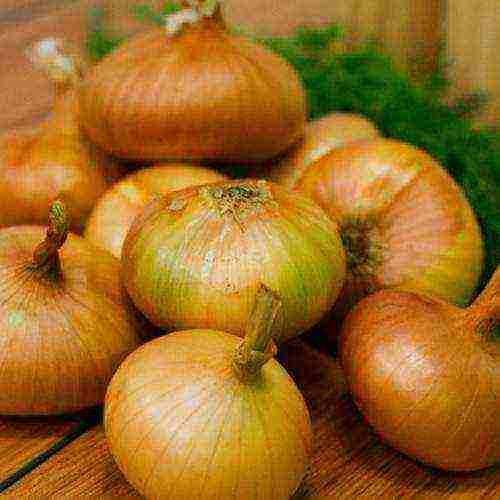
Vegetables will be stored for up to 9 months with virtually no loss. The average bulb grows to a weight of 55 grams. The variety belongs to the sharp types of onions and requires little or no maintenance. Matures in 60-80 days. It is convenient to grow this onion, both for yourself and as a product for sale.
Onion variety Buran photo
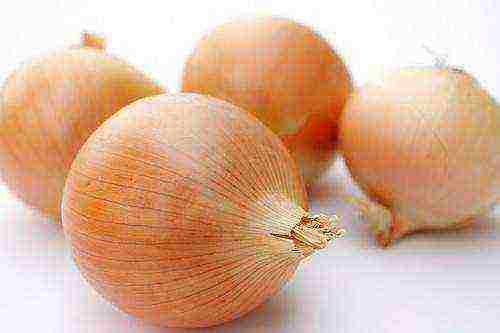
Belongs to late varieties, gives a rich harvest. With normal care, up to 12 tons of onions can be obtained from one hectare of land. The average weight of one onion is 100 grams. Vegetables have a marketable appearance, grow well with a two-year growing cycle. They tolerate weather conditions and an unfavorable environment adequately.
Onion variety Arzamas photo
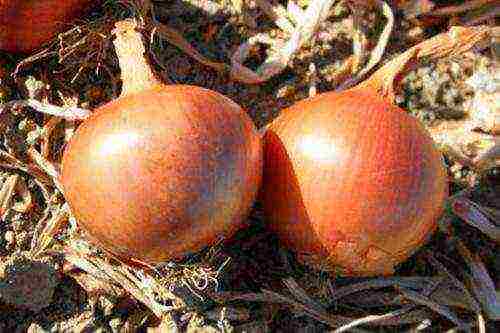
The variety was bred in 1943 and is popular to this day. The ripening period is around 100 days. The onion has a good appearance, it tastes bitter. It lays well in winter and does not create problems when growing.
Moldavian onion variety photo

This type of vegetable can be grown throughout the country. The variety is considered universal, in the second year it is better to buy new seed. If you leave the grown bow for planting, it will go to the arrow. Average bulb weight is from 55 to 100 grams. If the vegetables are well cared for, the bulbs can grow up to 200 grams in one piece.
Keeps well in winter and is well suited for marketing. The variety gives a very rich harvest. You can get 25 tons of onions from one hectare of land. When the planting was carried out closely, the yield of onions reaches 38 tons per hectare of land.
Onion variety Boterus photo

This type of onion grows well from seeds (nigella), it can be planted in the second year already with small bulbs. The crop will lie well in the pantry until spring. The average weight of one fruit is 60 grams. At the time of harvest, the ripeness of the onion is 85%. If the vegetables settle down a little, then the percentage of preservation will reach 90-95%.
Onion variety Red Baron photo
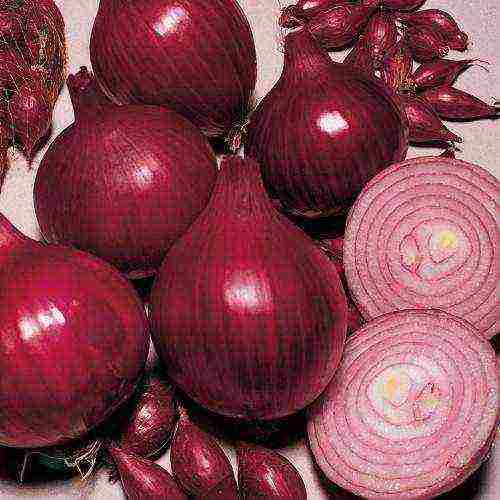
The variety yields about 1.5 kg of vegetables per square meter of land. The bulbs are burgundy blue in color, both on top and on the inside. The onion tastes bittersweet and can be stored until spring. Vegetables are excellently grown, both with sevk and with the help of seeds.
From the moment of sowing to lodging of feathers, it takes from 95 to 100 days. In general, onions are suitable for home cultivation and marketing.Unusually tasty onion of this variety in salads, and as a spicy addition to side dishes and soups.
Siberian annual onion variety
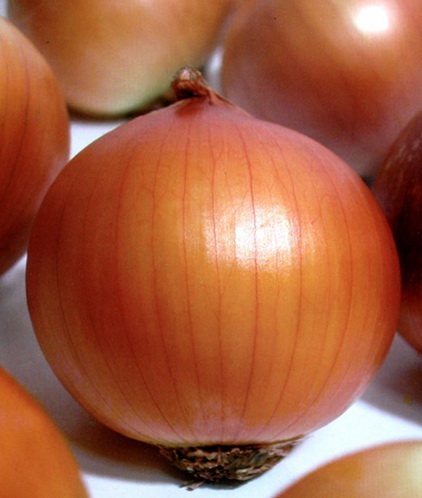
In the second year, no one leaves this onion variety. Basically it is grown from seeds, onions ripen after 95 days. The bulb produces a lot of green feathers, they can be sold separately at the time of a shortage of greenery.
Average weight of onion fruit is 200 grams. If little attention was paid to the beds, then the onion grows to 100 grams. The variety is resistant to the appearance of arrows and is excellently stored in winter.
Onion variety Black Prince photo
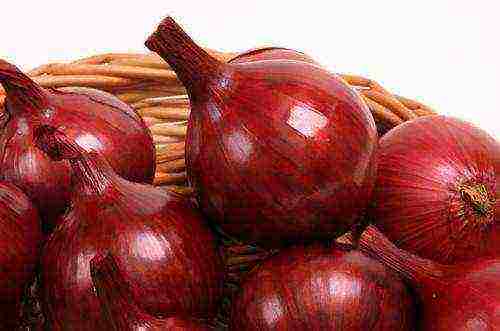
A very interesting variety of onions, the yield is record. Up to 50 tons of vegetables can be obtained from one hectare. Onions are perfectly stored in winter, they do not rot. Can be planted with sevka or with seeds. Vegetables have a burgundy, almost black color and a bitter taste.
The minimum bulb weight is 60 grams. The variety is universal, well suited for sale, fresh consumption and harvesting.
Strigunovsky onion variety photo
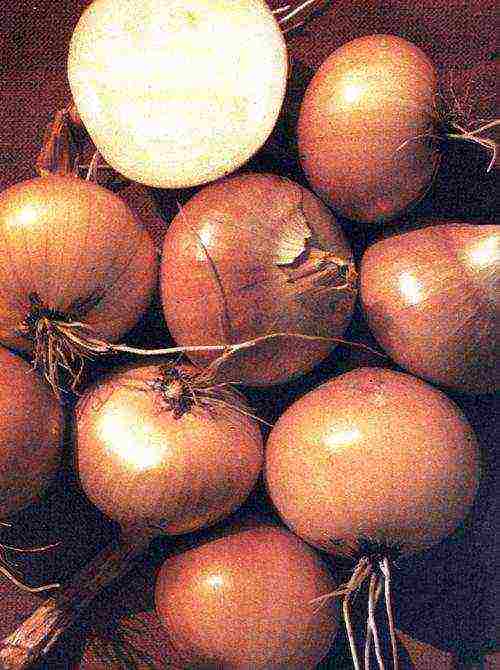
The variety can grow well throughout the country. It is considered an early type of onion and ripens on the 80th day from the moment of planting, provided that it was planted with a set. If the cultivation is done from seeds, then the ripening of vegetables will come 130 days from the moment of sowing.
Vegetables are well stored in winter, do not rot, do not deteriorate, and have a beautiful appearance. Small bulbs grow from 45 to 80 grams. The meadow is spicy and bitter to the taste.
Timiryazevsky onion variety photo

Was withdrawn in 1968, now removed from the state register. Nevertheless, it continues to grow in private gardens. Onions ripen by 95-100%, depending on the weather. It is best to grow it with sevkom. During the winter, up to 95% of the harvest is preserved. Overall, not a bad variety for private cultivation.
Onion variety Exibishen photo

Gives a rich harvest, easily tolerates cold, rather resistant to diseases. If vegetable care is systematic, each bulb can grow up to 800 grams in weight. The skin is firm, the flesh is white. The onion tastes sweet and can be stored for a long time in winter. Vegetables have a chic appearance and are good for sale.
The variety belongs to the late varieties, it is planted only with seeds. You cannot leave the finished harvest for the next year.
As you can see, many varieties of onions can be grown in the Urals, and they will give a stable harvest. Provided that there is maintenance behind the beds and normal soil moisture is maintained.
Onion varieties for central Russia
Central Russia opens up other opportunities for gardening. Dozens of onion varieties grow here, give a rich harvest with minimal effort. What varieties of onions grow with photos and descriptions, see this section.
Onion variety Shetana MC photo
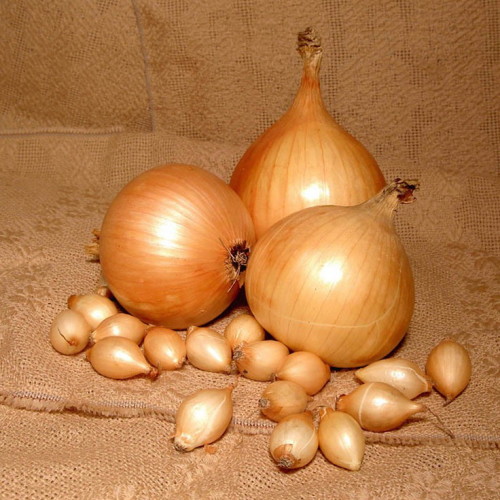
The variety can be grown from sevka in the northern regions. If we talk about the west and south of the country, then here the onion grows beautifully from seedlings. On average, the weight of the fetus is around 45 grams. If planted from seed, then the weight of the bulb will increase to 90 grams.
With the method of growing from seeds, you can get up to 600 grams of crop per square meter. By growing onions from sets, you will get 3 kilograms per square meter. You can combine the type of cultivation. Onions are grown for seeds from nigella, for sale or for their own diet - from sets. The crop keeps well and tolerates the winter in the pantry.
Onion variety Stuttgarner Riesen photo
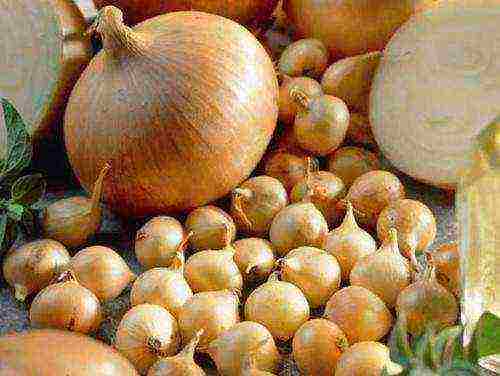
this type of onion came to our country from Germany. It can be grown through seedlings or using seedlings. The average yield per square meter is in the region of 3.5 kilograms. The bulbs grow large, weighing about 100 grams.
The onion tastes bittersweet. The fruits have a good appearance and are large in size. Vegetables look appetizing on the counter, they will be sold quickly.
Onion variety Spirit F1 photo

The variety was bred by breeders from Holland. It grows well in our country, gives a rich harvest and is well stored. Average bulb weight is about 50 grams. Good care and suitable soil will allow you to get a crop of up to 100 grams per bulb.
During storage, the onion does not sprout. It can be planted from seed, by sowing, or by seedlings. The cultivation method is chosen depending on your region.Overall, this type of onion is a good opportunity to harvest delicious onions.
Onion variety photo

This type of vegetables is stored until autumn. The average fruit weight is from 30 to 60 grams. By growing this type of onion, you can get a harvest of up to 3.5 kilograms per square meter. If you do not devote time to caring for onions at all, you will get only 1.5 kg per square meter.
Vegetables ripen well, have a beautiful appearance. This variety is grown mainly for personal purposes. If you want to grow vegetables for sale, go for the large bulb variety.
Onion variety Mayachkovsky 300 photos

This onion variety is considered early. It can be used both for implementation and for a home table, blanks. A large harvest can be obtained if grown like annual vegetables. The variety grows well through seedlings or as seeds.
The average yield of vegetables per square meter is in the region of 3 kilograms. The average fruit weight is about 70 grams. The bulb has a shiny skin and looks beautiful.
Onion variety Mstersky photo

Vegetables are grown from seeds or from seedlings. The average fruit weight is approximately 40 grams. With good care, you can grow crops up to 2 kilograms per square meter. Vegetables grow well throughout the country, including the northwest region. They can be stored until autumn, used for freezing and preservation.
Onion variety Odintsovets photo

The onion is intended for cultivation throughout the country, it grows well in the Moscow region. The average fruit weight is about 80 grams. This type of onion is considered early. Can be grown from seed, yield approximately 1.6 kilograms per meter of land.
If the cultivation is done from seedlings, then the yield will grow to 3.6 kilograms from one meter of soil. Odintsovets can be used for forcing greens and selling them in winter and spring. Serious care is not needed for vegetables, a standard scheme of actions is enough.
Onion variety Danilovsky 301 photos

This type of vegetables has an average ripening period, gives a good harvest. The onion is purple in color, weighs up to 150 grams in one piece, and has a mild taste. Stored in the pantry with average losses. On the garden bed it ripens normally, practically does not rot. We can say that this type of vegetables is one of the most delicious varieties of onions that can be grown in the middle zone of the country.
Onion variety Commissar photo

The onion has a purple hue, rather large sizes (up to 150 grams). In the pantry, it can lie without loss for up to six months. Well suited for implementation, looks beautiful on the counter. If the land is fertile, and onion care is regular, then from one square meter you can get up to 3.3 kilograms of vegetables.
Careless maintenance and poor land yield a yield of 1.2 kilograms per square. The variety has an average ripening period. You can plant vegetables by seeds or through seedlings. Mainly grown as an annual plant. The harvest in this case is rich, the bulbs are large.
Onion variety Hercules F1
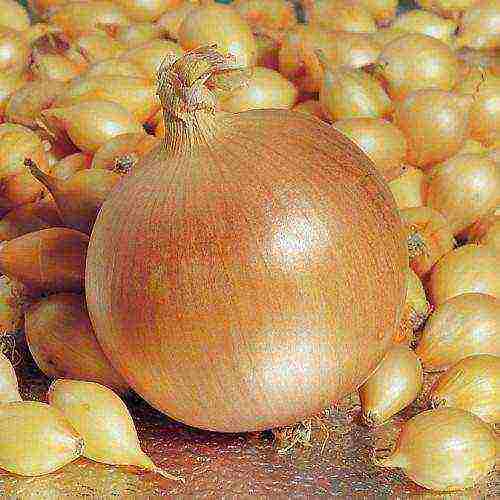
Onions grow large in any region. Each onion has a dense, shiny skin, 160 grams in size. The average onion yield is about 5 kilograms per square meter. Vegetables can easily lie in the pantry for a long time. The only condition is darkness and coolness. In such conditions, the onion will not sprout. Vegetables are grown with the same enthusiasm for both fulfillment and personal needs.
Onion variety Alvin photo
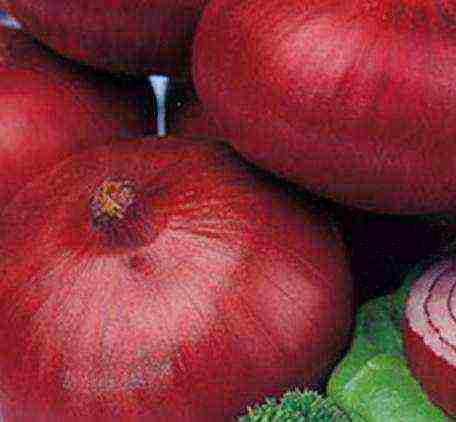
This variety can be grown as an annual crop. In this case, you need to sow or seed or plant seedlings. Onions grow well from sets, they give larger and more elastic bulbs. The average fruit weight is about 60 grams.
Vegetables are great in the pantry for 7 months. The crop can be harvested up to 2.6 kilograms from one square meter garden.
Onion variety Albion F1 photo
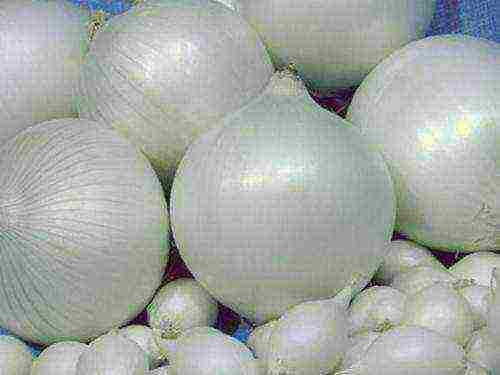
A hybrid variety brought to our country from Holland. Produces white onions, each weighing about 100 grams. The variety is grown through seedlings, tolerates adverse conditions well, and is resistant to diseases.In a basement or pantry, it can be stored until the New Year.
Onions of this variety are good, both for personal consumption and for sale.
Onion variety Globo photo
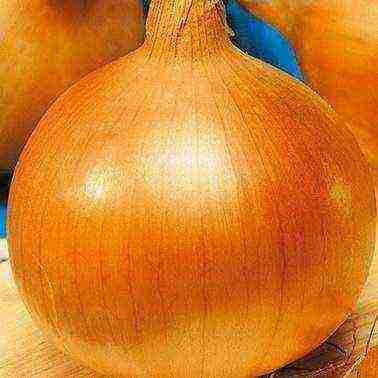
This type of onion has an average ripening period. The bulbs grow large, weighing up to 1 kilogram. We can say that this is one of the largest varieties of salad-type bulbs. A vegetable is grown by planting seedlings. It has a sweet taste and great juiciness.
Such a bow can be used for realization, as a decoration of dishes, or as an ingredient in a salad. Growing it is no more difficult than any other type of onion.
Onion variety Schnitt photo
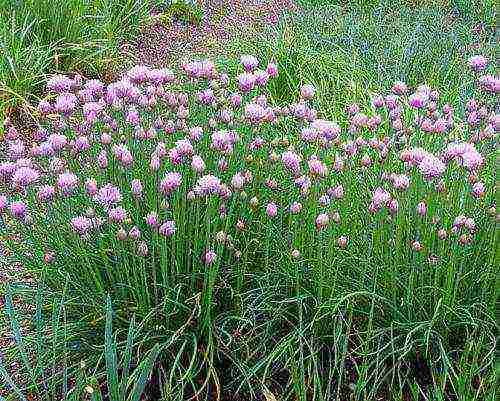
This variety is grown for the sake of greenery. It has a beautiful appearance. On the counter, such shoots will look delicious and rich. There are many nutrients in onion greens, it is densely included in diet food. Onions are grown by sowing seeds and only greens are harvested. Such a vegetable cannot be grown for storage.
Onion shoots of this variety are perfect for freezing for the winter, for decorating dishes and as an addition to slicing meat and lard. You now know how to choose onion varieties with photos and descriptions. Choose the type of vegetables that will fully satisfy your needs. You can plant several species at the same time and see which one suits you.
For commercial cultivation, choose varieties with a long shelf life. The system of caring for vegetables does not create problems, you will get a rich harvest with a minimum investment of time.
Growing technology and care of onions in the open field (with video)
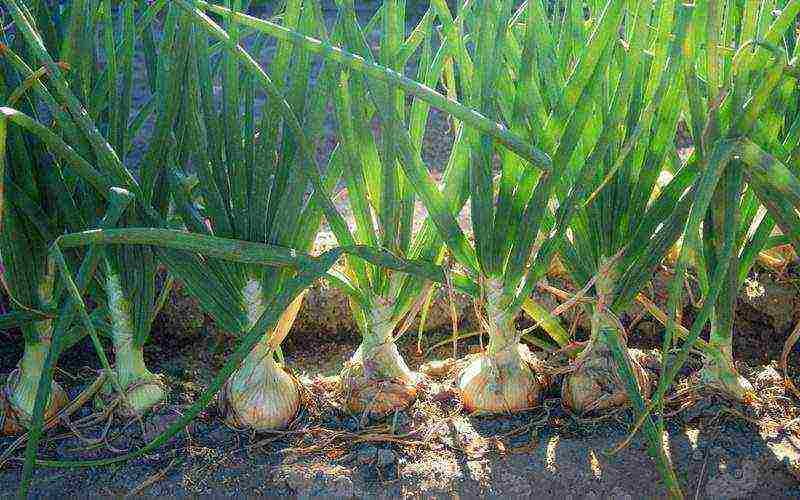
Onions in the photo
Of the cultivated species, onions are the most widespread. It is not very rich in vitamins. True, green onions contain much more vitamin C than onions, more potassium, calcium, phosphorus, and iron salts in it. But the main advantage of all types of onions is essential oils, which stimulate gastric secretion, increase appetite, and, finally, phytoncides are fierce enemies of bacteria.
Using one or another cultivation technology, onions can be grown in one year from nigella seeds and in two years from onion sets.
With an annual onion culture, seeds are sown as soon as the soil allows in March. The time from sowing to emergence is 21 days. They accelerate the emergence of seedlings by pre-sowing heat treatment of seeds, soaking them, including in growth stimulants. During the period of seed germination and after the appearance of the fifth leaf, onions must be watered. With a lack of moisture in the soil, the growth of leaves stops, and small, underdeveloped bulbs are formed, even if there are only 2-3 true leaves. Then the plant falls into a dormant state. This phenomenon in onions is irreversible. Therefore, violation of agricultural techniques for growing onions in the open field, especially in the first 70-80 days of growth, can lead to large crop losses.
For the successful cultivation of onions, seeds are sown in rows, the distance between them is 20-25 cm, the planting depth is 2-3 cm.It is useful to mulch onion crops with humus, which prevents the appearance of a soil crust, retains moisture in the soil, which contributes to the appearance of friendly shoots.
At first, onion shoots grow very slowly, they need to be watered and loosened. Loosening should not be deep (4-5 cm) so as not to damage the root system.
When 1-2 true leaves appear, the first thinning of crops (up to 1.5-2 cm) is carried out in strongly thickened places, removing weaker plants. After the formation of 3-4 leaves, a second thinning is done already at the final distance of 4-6 cm.
When growing and caring for onions with thinning, as with watering, you must not be late. Otherwise, thickening and dryness of the soil accelerate the formation of small bulbs with an insufficient number of leaves.
For growing onions through a set, healthy bulbs are used. After winter storage, the sets are sorted out before planting.If in the previous year, during cultivation, the plants were affected by downy mildew, the seedlings should be warmed up 10-15 days before planting for 8 hours at a temperature of + 40 ... + 42 ° C for disinfection. The high temperature will also help reduce plant shooting.
Sevok is planted, without deepening, in April in heated soil. Planting too early will cause arrows to form; later planting will reduce the yield. The arrows that appear break out.
The video "Growing Onions" shows all the main agricultural techniques:
Pay attention to the photo - when growing and caring for onions, when the bulbs are poured, the soil or mulching material is raked away from them so that the ripening crop is in the sun:
Watering should be stopped 2-3 weeks before the expected harvesting date, the bulbs should ripen well. A sign of readiness of onions for harvesting is mass lodging of leaves. Harvested in dry weather.
Traditional varieties of onions for a turnip are those with large, flattened or globular bulbs that can be stored throughout the winter. The color of the scales varies from almost white to bright red; the taste of the onion ranges from mild to pungent. Most varieties are planted in the spring, but there are varieties that are planted in the fall and harvested at the end of July of the following year. In the south, with mild winters, Japanese varieties are the most reliable when planted before winter, but they are unsuitable for long-term storage.
Remember!
Onions grown for feathers are not treated with any pesticides.
Leaves are not cut from onions planted to obtain a turnip.
A good harvest of onions can only be obtained in a sunny place, free from the roots of perennial plants (trees and shrubs).
Seed-grown onions keep better. Onions with yellow and dark red skins are especially well kept.
From seedlings stored at temperatures from + 1 ° C to + 18 ° C (constantly or periodically), the plants quickly go to the arrow.
The best varieties of onions and their photos
Among the varieties of onions there are early ripening, mid-ripening and late ones.
"Iris" - early maturing, unilocular, peninsular. Bulbs are round, medium density, weighing 70-100 g, individual bulbs - up to 200 or more. 1/3 located on the surface of the soil, which accelerates maturation and facilitates harvesting. High-yielding, well stored in winter. Commercial bulbs are grown in one year.
"Myachkovsky local" - early ripening, excellent taste. The bulbs are round, flat, medium-dense, semi-sharp in taste, weighing
60-90 g, small-celled, 2-3 primordia in the bulb. Average tenderness.
"Penguin" - early maturing, semi-acute. Commercial bulbs are grown in one year, sowing seeds in the ground, but you can also through sowing. The weight of each bulb is from 50 to 150 g. Yielding. In the soil, the bulbs are placed 2/3, which promotes good ripening and facilitates harvesting. Keeping quality is good.
"Stuttgarter Riesen" - early ripening (66-73 days of vegetation), bulbs are flat-rounded, color from golden yellow to yellow-brown; single-leaf bulb with a pungent taste, weighing 50-95 g, high yield, good storage. This is one of the best varieties of onions, as it is highly resistant to downy mildew. Grown in a biennial culture.
Shetana - mid-season variety (90-110 days), round bulb, golden-yellow color, with 1-2 primordia, semi-sharp to the taste, weighing 70-85 g, grown in annual and biennial culture.
"Strigunovsky local" - mid-season variety (77-98 days). Sharp, fruitful, perfectly stored, small-nested - 2-3 primordia in the bulb. The bulb is round, yellow-brown, weighing 45-80 g. It is grown in an annual or biennial culture.
Danilovsky 301 - mid-season (90-100 days), small-breeding (2-3 primordia), semi-sweet taste. The bulbs are flat, dense, weighing 70-150 g, dark red with a violet tinge, indispensable for salads, very fruitful. Grown in annual and biennial crops.
"Chalcedony" - mid-season, with a spicy taste, dense bulbs, weighing 90-130 g. Bulbs are 1/3 above the soil surface, which promotes ripening and facilitates harvesting. Stores well. Commercial bulbs are grown in one year.
"Karatalsky" - mid-season (93-125 days of vegetation). Bulbs are 1-2 rudimentary, semi-sharp on the palate. Grown in an annual culture.
As you can see in the photo, this variety of onions has round, yellow, sometimes golden yellow bulbs weighing 50-120 g.
"Odintsovets" - mid-ripening (100-120 days), small-breeding (3-4 primordia), semi-sharp taste, round-flat bulb, golden yellow, weighing 55-80 g. Very good keeping quality. Suitable for annual crops. Can be grown for two years.
Brunswick - mid-season, rounded flat bulbs, weighing 80-120 g. The outer scales are dark red. The inner ones are white with red rings. Weakly affected by diseases. Stores well.
"Carmen" - mid-season variety. The bulbs are round, dark red in color. This is the darkest colored onion variety. The taste is spicy. Stored medium.
"Lugansky" - late variety, vegetation period 115-158 days, bulb color is yellow with a brown tinge, round-flat shape, 2-3 buds in the bulb, taste spicy or semi-sharp, weighing 75-150 g. With good watering it is grown in annual culture.
"Russian size" F1 - the largest of the onions - weighing up to 3 kg.
"Densimore" - the bulb is round, weighing up to 120 g, dry scales are strong, greenish-yellow in color, adjoining juicy white scales.
"Silver Prince" - medium late variety. Dry scales are white-silvery. The bulb is round, weighing an average of 50 g. It is used for herbs and turnips.
"Globo" - a late variety of lettuce onions with excellent taste. The bulb is large, broadly elliptical, straw yellow. The average weight of the bulbs is up to 700 g.
"Bonus" F1 - mid-season (100-105 days). The bulbs are round-flat, weighing 80-120 g. The outer scales are dark red, the inner ones are white with red rings. The taste is semi-spicy.
Growing, care and reproduction of shallots (with photo)

Shallots in the photo
More early ripening, productive, it is more dense, transportable and keeping quality in comparison with onions. The bulbs are hardy, they can freeze and thaw without damage, while retaining the ability to regrow. Virtually no arrows.
Multifaceted bulbs (shrews), from one bulb you can get a nest weighing up to 500 g, containing up to 40 bulbs of 15-30 g, depending on the variety. Prized for its special pungent taste, it is considered the best onion for cooking. Bulbs for planting are stored in a cool, bright place.
Reproduction of shallots is carried out, as a rule, vegetatively, that is, by dividing the bulb into shares. When planted in autumn, the shrike produces a large number of seeds. Reproduction of shallots through seeds has health benefits. This onion has more delicate leaves than onions. From 30 to 35 leaves are formed on the bulb, which is 3-4 times more than that of a turnip. Ripen 1-1.5 months earlier than the last.
Mainly cultivated for early greenery in open and protected ground. Small lobes are planted in grooves 4-6 cm deep, the distance between them in a row: on a turnip - 8 cm, on greens - 4 cm, the aisles are the same as for onions.
When growing shallots in greenhouses in winter, remember that shallots have a deep dormant period. Therefore, before planting the bulbs, it is necessary to cut the neck to the shoulders and warm it up in water for 2-3 hours at a temperature of + 40 ... + 45 ° C.
Shallots require significantly less watering than onions, which is very important in places with a lack of irrigation water. Otherwise, the care is the same as for onions.
Check out the basic techniques for growing and caring for shallots in these photos:
Shallot varieties and their photos
Atlas F1 - hybrid variety of shallots, early ripening, multi-bud bulbs, dense, beautiful bronze-brown color, excellent taste, shelf life for a long time.
"Bessonovsky local" - early ripening (55-78 days from emergence to technical ripeness), drought-resistant, cold-resistant, pungent taste. The bulb is round-flat in shape, golden yellow in color. In the nest there are 4-5 bulbs weighing 40-65 g. It is grown in annual and biennial crops. Keeping quality is very good.
"Russian purple" - vegetatively propagated variety, high-yielding, early maturing, ripens in 90-100 days. The color of dry scales is violet. Forms 10-20 round-flat bulbs in the nest. One of the best shallots, the bulbs are good keeping quality.
"Kuban yellow" - medium-nesting, high-yielding variety (6-10 bulbs per nest), with a semi-sharp taste. The color of dry scales is yellow with a pink tint. Ripens in 90-110 days. It tolerates low soil moisture well.
"Sprint" - early ripening variety, the period from full sprouting to mass lodging of leaves is 55-60 days.
Pay attention to the photo - this variety of shallots has round-flat bulbs, yellow, small-bud (the number of buds is 3-9):
Bulb weight is 25-45 g. The leaves are wide enough, almost like onions, but turn yellow early.
Growing and caring for chives in the open field (with photo)

Chives on the photo
Chives are a perennial herb that produces good greens throughout the year. In the open field, in one place, you can grow for four to five years. This plant can be grown in greenhouses and even in a room. The leaves of chives are very delicate, slightly pungent and fragrant. They contain vitamin C, carotene, sugar, essential oils, mineral salts. In terms of chemical composition, this is one of the most valuable vegetable onions; in terms of calorie content, it surpasses onions. In spring it grows back very quickly and forms a large green mass.
To obtain the highest yield, cultivation of chives is best done on moist, weed-free soils. It can be grown by sowing seeds in open ground in early spring with a seeding depth of 0.5-1 cm or vegetatively by dividing bushes. Bushes are planted at a distance of 20 cm from each other, divided every 3-4 years. With prolonged cultivation for more than four years, 50-60 daughter plants are formed in the bush, the leaves become small, the yield decreases. Chives, after seed ripening in June, grows back and gives good greens in the second half of summer and autumn.
When growing chives, caring for plants includes loosening, watering, weeding. Water regularly; the best condition for growth is a sunny place. Young greens are harvested several times during the growing season. Leaves are cut at a height of 2 cm above soil level. If you are interested in getting greens throughout the season, then cut the leaves whole, and do not pinch off the tops, and do not let the onions bloom.
It is possible to use this type of onion as an ornamental culture, as it forms openwork spherical inflorescences of pink or purple color.
Look at the photo of growing chives and caring for plants to better understand how all the basic agricultural techniques are performed:
The best varieties of chives
"Honey plant" - mid-early, semi-acute. The period from the emergence of mass shoots (regrowth of leaves) to the beginning of harvesting is 36-50 days. The variety is characterized by amicable growth of greenery in spring and long-term yield, which is up to 2.5 kg / m2 per season.
"Albion" - mid-season, winter-hardy variety of chives. For one onion 2-3 leaves. The length of the leaves is up to 38 cm, the width is 0.6 cm, the length of the false stem is 2.2 cm. The weight of one plant is 15-18 g. The taste is spicy. The yield per cut is 1.7-2.0 kg / m2.
"Spring" - mid-season, winter-hardy variety. The plant forms a powerful bush with a high degree of branching, up to 60 cm high. Leaf length 38 cm, width 0.8 cm. False stem up to 10 cm long. The taste is weak.Productivity for the growing season is up to 6.0 kg / m2 (3-4 cuts).
"Nemal" - the mass of leaves on one plant is 580 g, false bulbs 290 g, the predominant color of the leaves is green, with a medium waxy bloom. The taste is spicy. The optimal yield is 6.84 kg / m2. It is cultivated on a green feather as an early spring vitamin green.
"Erecta" - forms a rich green mass with delicate leaves of a pleasant taste. It blooms with beautiful, large, pink-lilac flowers.
Growing conditions and care for leeks (with video)

Onion -porey in the photo
This type of onion resembles garlic in appearance. But this is only an external resemblance. The leaves are flat, folded along the central vein up to 50-60 cm long. It does not form bulbs; leaves and a dense bleached stem (leg) are used for food.
Leek is one of the most valuable types of onion. It has excellent taste and gives fresh greens until the very frost. This culture lacks a pungent smell and taste. Its aroma is softer, and its taste is subtler, more pleasant, sweeter than that of onions. Leeks contain vitamins C, E, B1, B2, PP.
As you can see in the photo, this type of onion is used as salad greens:
The lower leaves form a false stem 10-30 cm long, 2-5 cm in diameter. Leeks are also canned, salted, pickled, dried, frozen.
An important property of leeks is that during winter storage there is not a decrease, but a significant increase in the vitamin C content in the stem due to the outflow from the leaves.
Leeks are grown both by seedlings and by sowing seeds in the ground. The time from sowing to germination is 14-18 days. Seeds remain viable for 3 years.
It is a very moisture-loving plant, so one of the conditions for growing leeks is to provide the plants with sufficient water. The culture is very demanding on soil fertility. If organic fertilizers were not introduced for digging in the fall (10 kg of humus per 1 m2), then during the growing season, additional feeding with infusion of mullein or chicken droppings should be carried out.
A distinctive feature of caring for leeks during cultivation is that in the second half of summer (in July, August) it must be hilled 2-3 times. This exercise allows you to get a long, delicate, well-bleached leg. Although the leaves of the leek grow until late autumn, you should not delay harvesting, especially if the onion is intended for storage.
In warm years, leek winters well in the open field.
The video of growing leeks shows all the main agricultural practices:
The best leek varieties for the middle lane
Among the best varieties of leeks are:
"Karantansky" - late ripening variety, vegetation period 125-176 days from germination to technical ripeness. Semi-sharp, the leg is short - 10-25 cm, cylindrical in shape, the thickness in the middle part is 5 cm, the mass of the leg is about 100 g.
"Winter giant"... Due to its frost resistance and late ripening, the variety is especially valuable for consumption in winter. This leek variety forms a thick, long stem with a wonderful mild flavor. Disease resistant, stored until May.
"Elephant's trunk" - biennial plant. Leaves 80-90 cm long, covered with a waxy bloom, delicate, slightly pungent in taste.
"White Lisbon" - special type of onion for salad purposes. Forms rich, juicy greens of pleasant taste with a massive, thick and very delicate base. In the middle lane, this variety of leeks can be planted before winter - then you will provide yourself with the earliest spring greens.
"Russian size" - a plant with a giant "leg" of at least 60 cm. Early ripening, valued for its high potassium content.
The best varieties of onion-batuna, planting, care and cultivation
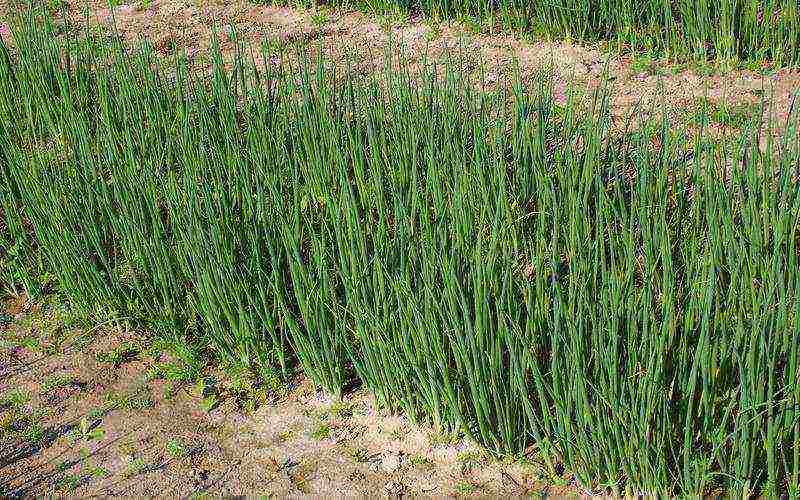
Onion-batun in the photo
Batun onion is a perennial herb, does not form bulbs, branches strongly and forms a large leaf mass, contains twice as much vitamin C as onions, in addition, it is rich in carotene, vitamins B1, B2, D, proteins, phosphorus salts and copper.
Among the varieties of onion-batun, the most famous is "April". This is an early ripe variety, from germination to technical maturity, it takes 30-40 days. The color of the leaves is dark green, with a weak waxy bloom, the weight of the plant is 200-300 g. The taste is semi-sharp, the leaves are tender, juicy, do not coarse for a long time.
"Russian winter" - mid-season, winter-hardy variety. This one of the best varieties of onion is cultivated in both annual and perennial crops. The taste is semi-sharp, the leaves are tender. With a long-term culture - 2-3 cuts of green feathers per summer.
When growing and caring for the onion, keep in mind that it is a light-loving, cold-resistant plant. It tolerates spring frosts down to -10 ° C. Plant development begins in spring at a temperature of + 2 ° C. It can grow in one place for 4-5 years. With regular harvesting, the leaves will grow back throughout the summer.
The plant is propagated by seeds and dividing the bush. Planting and caring for batun onions can be carried out during the spring and summer. The seeding depth is 2-3 cm. When multiplying by dividing the bush, one plant gives 5-7 daughter plants per year. It is better to transplant at the end of August - September, while the leaves are cut off so as not to cover the growing point. After planting, when growing onions, watering is required.
Multi-tiered onions: planting, care and cultivation (with photo)

Multi-tiered bow in the photo
The tiered bow is a type of perennial bow. Outwardly, it looks like onion and batun. Just like onions, this type of onion forms fist-like leaves and a true basal bulb. Its main difference from the batun and onion is in the structure of the flower arrow.
Look at the photo - the arrow of a multi-tiered bow ends not with flowers, but with air bulbs located in 3-4 tiers:
The largest air bulbs (bulbs) are on the 1st tier, the smallest ones on the 3rd and 4th. Does not form seeds, propagates only vegetatively - air bulbs and basal bulbs by dividing the bush. It grows in one place for 4-5 years. Very winter-hardy. It tolerates frost well down to -40 ° С.
In multi-tiered onions, all parts of the plant (leaves, basal bulbs and bulbs) are eaten fresh and canned. They are used as a seasoning for the first and second courses, in the preparation of meat and vegetable okroshka, various salads, marinades. The green leaves of this onion are a good decoration for snack dishes (cold fish, caviar, mushrooms, etc.).
To grow multi-tiered onions for digging the soil before planting, add a bucket of humus, 20-30 g of superphosphate, 15 g of potassium chloride, 10 g of ammonium nitrate per 1 m2. Planting in spring gives the onion an opportunity to take root, it grows rapidly, and by winter it accumulates nutrients. Bulbs are planted before winter (in October - November). Spring planting of an early good harvest in the first year does not.
The onions are planted in an ordinary way, the row spacing is 40-45 cm, to a depth of 3-5 cm.For ease of care, when planting a multi-tiered onion, an interval of 3-4 cm is left between the plants. During the growing season, care consists in weeding, watering, loosening, feeding organic fertilizers.
These photos of growing multi-tiered onions show how to care for plants in your garden plot:
Cuts of feathers begin in early spring when they reach a height of 25-30 cm, you can, if necessary, cut off younger greens throughout the summer. The highest yield is given by 2-3-year-old plantations.
Bulbs and basal bulbs do not have a dormant period, therefore, after removing them from the plant, they can be planted immediately, before planting, the nests of the bulbs are divided into separate bulbs.
The cultivation and care of this type of onion in the off-season is carried out in hotbeds and greenhouses. This requires a temperature of only plus + 10 ... + 12 ° С. You need to store onions for forcing with a whole nest in the ground. They root well, branch out and form a green mass after 35-40 days. By means of pavement (solid) planting per 1 m2, 10-12 kg of bulbs will be required. The yield of green feathers is 13-18 kg per 1 / m2.
The value of this onion lies in the fact that, in comparison with others, it contains an increased amount of ascorbic acid (in the leaves - 50-75 mg, in the bulbs - 30-50 mg per 100 g of raw mass), a lot of essential oil. There are also vitamins B1, B2, PP, carotene. The phytoncidal activity of multi-tiered onions is also slightly higher than that of other perennial types of onions (batun, schnitt, slime).
Rate the article:
(3 votes, average: 4.7 out of 5)
